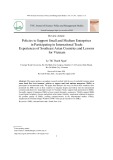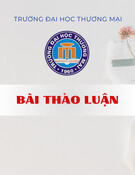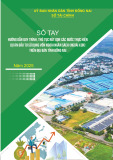
Vol. 6, 2020
A new decade
for social changes
www.techniumscience.com
9 772668 779000
ISSN 2668-7798

Internationalization of SMEs; Evidence from Mexican
Leather Footwear Industry
Y. D. Cisneros-Reyes1, D. C. Caldera-Gonzalez2, M. G. Arredondo-Hidalgo3
ycisneros@ugto.mx1, calderadi@gmail.com2, lupita@grupocrea.com.mx3
Abstract. Despite Mexican leather footwear industry is traditional, it has not increased or even
maintained the level of competitiveness in the global market; the export problems of SMEs
(Small and Medium Enterprises) have been studied by some authors but the
internationalization (beyond exports and imports and including foreign direct investment,
international subcontracting and international technical cooperation) has not been deeply
explored so it is not documented how the process of this economic segment is occurring and if
that is evolving accordingly to the theory (E.g. Uppsala model). The objective of this study is
to analyze the internationalization of SMEs of the Mexican leather footwear industry to know
if accumulated knowledge and experience in foreign markets effectively leads the organization
to more advanced and complex stages of international exchange. A survey composed by 47
questions was applied to a sample of 21 SMEs of the Mexican leather footwear industry, their
experience was also collected by semi-structured interviews. Results show that SMEs are
involved in the internationalization process strongly oriented to the development of exports and
imports and only a small number of them have been able to reach the stage of foreign direct
investment. These results suggest that internationalization is only conceived in terms of
imports and exports and efforts are carried out only to those stages even if SMEs could obtain a
great benefit from the rest of the internationalization exchange (FDI, international
subcontracting and technical cooperation). This behaviour might be due to some factors as: (1)
the relatively low level of competitiveness of the Mexican firms in the global industry, (2) the
lack of know-how and (3) the vision of the owners and managers of the company.
Keywords. Internationalization, SME, Footwear Industry.
1. Background and Problem Statement
In this dynamic era of globalization, small and medium enterprises (SMEs) play a pivotal role
in the development of a country [1]. Ultimately, only companies themselves can achieve and
sustain competitive advantage which arises from leadership that harnesses and amplifies the
forces to promote innovation and upgrading. Globalize to tap selective advantages in other
nations is a company policy that supports the important effort of adopting a global perspective
to create competitive advantage [2].
Internationalization is suggested to be a gradual process; the Uppsala model postulates that
firms go through this way [3], [4] and although that model was developed based on the
internationalization process of relatively large size firms, it is equally useful for analyzing the
exporting challenges and opportunities of SMEs as well. The development of SME’s
internationalization is a critical path since they are more challenged than larger firms because
160
Technium Social Sciences Journal
Vol. 6, 160-166, April 2020
ISSN: 2668-7798
www.techniumscience.com

of the lack of resources and capabilities; thus larger firms are more likely to overcome the
challenges of exporting than SMEs [1].
Then, knowing the route to succeed the global competence is relevant however findings are
heterogeneous: for instance, [5] states that firm size determines how trade barriers are
perceived while [6] stablishes that the perception of impediments varies between firms, in
such a way that those with less experience perceive a higher incidence of problems in
international business than the firms having more experience.
Other authors that have approach to the topic of internationalization of SME [7] suggest
that export barriers and problems do not affect all the firms in the same way, and that the best
predictor of whether a particular firm identifies a problem as relevant, is explained almost
exclusively by the number of years the firm has been exporting. This supports the idea that
experience is an essential factor for the success of exporters in overcoming and tackling
export problems [8].
[9] states that manufacturers with a few years in business are more vulnerable to export
barriers than experienced firms; that small and less profitable business units show greater
vulnerability to export problems and that those lacking background organizational support
experience greater export problems. Also, [10] postulates that in terms of internal barriers, the
SME owner/manager’s lack of vision may stem from their inability to think strategically
about business in general.
[5] finds that export barriers can indeed influence the path to internationalization and that
export barriers may have an under-researched effect: inducing choice of internationalization
path, additional to the vast majority of traditional literature that stablishes that export barriers
prevent internationalization, inhibit international performance, and prompt de-
internationalization.
The worldwide leather industry is mainly conformed by SMEs and research of global
competition is continuously being developed in that area. For instance, [11] mention that
countries which grow their brand images such as Italy and Spain come to the forefront in the
world market by emphasizing their quality, while China, India and Brazil emphasize cheap
labor and low cost.
The apparel industry in Italy is an excellent example of a sector that has thrived based
largely on exports to industrialized nations of high-quality merchandise manufactured
domestically by Networked SMEs [12]. Italian industry mainly (80%) consists of SMEs,
exports to 116 countries and has comparative advantages. With its highly advanced tanning
industry, modern accessory manufacturers and innovative designs, as well as high quality,
branded products representing the latest fashion; Italy refers to upper income groups of the
world [11].
In Spain, leather processing and leather product industries are among the traditional ones
and also generally consist of SMEs which gather under various unions and associations in
order to both maintain their domestic market shares and keep up with the competition in
exports [11].
The Portuguese footwear industry is defined as low-tech and traditional, dominated by
SMEs that applying new strategies made big changes in the image and performance achieved;
since 2009, exports have increased more than 55% and have grown in almost all the important
foreign markets. The competitive strategies followed by the Portuguese footwear companies
can be clearly identified according Porter’s three generic competitive strategies: cost
leadership, differentiation and focus strategy [13].
In Mexico, 15 300 firms are dedicated to the manufacturing of leather shoes and 99% of
them are SMEs [14]; Guanajuato State concentrates 70% of the national production but only
161
Technium Social Sciences Journal
Vol. 6, 160-166, April 2020
ISSN: 2668-7798
www.techniumscience.com

322 firms are exporters [15] which represents 3%. Despite Mexican leather footwear industry
is traditional, it has not increased or even maintained the level of competitiveness in the
global market; the export problems of SMEs have been studied by some authors [16], [17],
[18] but the internationalization (beyond exports and imports and including foreign direct
investment, international subcontracting and international technical cooperation) has not been
deeply explored so it is not documented how the process of this economic segment is
occurring and if that is evolving accordingly to the theory (E.g. Uppsala model).
2. Objective
The objective of this study is to analyze the internationalization of SMEs of the Mexican
leather footwear industry to know if accumulated knowledge and experience in foreign
markets effectively leads the organization to advanced and complex stages of international
exchange.
3. Methodology
In this study, internationalization refers not only to exports but to all activities that put SMEs
into a meaningful business relationship with a foreign partner: exports, imports, foreign direct
investment, international subcontracting and international technical cooperation using the
methodology proposed by the European Commission Enterprise and Industry [19]. The
definition of SME considered is the one proposed by INEGI: “Micro-enterprises, as having
fewer than ten employees; Small enterprises, as having fewer than 50 employees; Medium
enterprises, as having fewer than 250 employees”.
Fig. 1 Internationalization exchange stages of firms. Source: Created by authors based on
European Commission Enterprise and Industry (2015)
In order to establish the effect of experience accumulated by SMEs in advancing through
the different stages of the firms’ internationalization process, a survey composed by 47
questions was applied to a sample of 21 SMEs of the Mexican leather footwear industry, their
experience was also collected by semi-structured interviews.
The selection of cases was based on the fact that there is no ideal number of cases, but
choosing between 4 and 10 usually yields the results necessary for the investigation [20].
Similarly, the methodology recommended by the author states that the cases are chosen for
theoretical reasons and not for statistical reasons, so the search for the most representative
cases for the research exercise was developed.
Thus, the selection of companies was carried out among the attendees of regional public
events that promote the competitiveness and internationalization of the footwear industry.
These companies were selected since they met the following criteria: a) easy access to
information; b) participation in events, and c) willingness to be considered in the study. This
Exports
Imports
Foreign direct
investment
International
subcontracting
International
technical
cooperation
162
Technium Social Sciences Journal
Vol. 6, 160-166, April 2020
ISSN: 2668-7798
www.techniumscience.com

made the selected cases were interesting insofar as they allowed a comprehensive analysis of
the development and stage of internationalization.
For [20], the case study methodology aims at generalization and the construction of new
theories. In this sense, and following the author, to analyze the cases, it was assumed that the
use of multiple researchers improves the creative potential of the study, since the team
members provide complementary ideas. Thanks to the members of the research team, in-depth
interviews, observations and analysis of the information provided by SMEs were developed.
Finally, the information was triangulated in contrast to the theoretical framework and
literature. The following section presents the results of the case studies, which account for the
experiences of the 21 companies.
4. Results
Fig 2. Internationalization Stage of Mexican leather footwear industry, Source: Created by
authors.
Results in Fig. 2 show that SMEs of this sample are involved in the internationalization
process strongly oriented to the development of exports and imports and only a small number
(3) of them have been able to reach the stage of foreign direct investment, however these
relationships are so recent (less than one year) that the outcomes cannot be evaluated at this
point of the research. Additionally, no one of the surveyed companies expressed any interest
of commitment to advance neither to international subcontracting nor international technical
cooperation stages in the near future.
These results suggest that internationalization is only conceived in terms of imports and
exports and efforts are carried out only to those stages even if SMEs could obtain a great
benefit from the rest of the internationalization process levels (FDI, international
subcontracting and technical cooperation). This behavior might be due to some factors as: (1)
the relatively low level of competitiveness of the Mexican firms in the global industry, (2) the
lack of know-how and (3) the vision of the owners and managers of the company.
Despite the surveyed SME’s could be considered as advantaged in terms of their
international performance, and that was a key element to consider them in this research, the
investigation confirmed that the expectations of global participation are rather conservative
and thus resources destined to the international development are also restricted.
0
2
4
6
8
10
12
14
16
Imports
Exports
FDI
International
subcontracting
International technical
cooperation
163
Technium Social Sciences Journal
Vol. 6, 160-166, April 2020
ISSN: 2668-7798
www.techniumscience.com



















![20 câu hỏi Quản lý dự án phần mềm có đáp án [mới nhất]](https://cdn.tailieu.vn/images/document/thumbnail/2025/20251003/hieu2004haha@gmail.com/135x160/78791759734259.jpg)


![Tài liệu Quản lý dự án: Kiến thức nền tảng toàn diện [chuẩn SEO]](https://cdn.tailieu.vn/images/document/thumbnail/2025/20250910/kimphuong1001/135x160/92631757496585.jpg)



